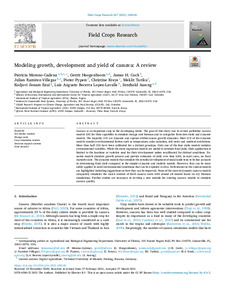| dc.contributor.author | Moreno-Cadena, L.P. |
| dc.contributor.author | Hoogenboom, G. |
| dc.contributor.author | Cock, J.H. |
| dc.contributor.author | Ramirez-Villegas, J. |
| dc.contributor.author | Pypers, P. |
| dc.contributor.author | Kreye, C. |
| dc.contributor.author | Tariku, M. |
| dc.contributor.author | Ezui, K.S. |
| dc.contributor.author | Lopez-Lavalle, L.A. |
| dc.contributor.author | Asseng, S. |
| dc.date.accessioned | 2022-09-28T10:48:28Z |
| dc.date.available | 2022-09-28T10:48:28Z |
| dc.date.issued | 2021-06-15 |
| dc.identifier.citation | Moreno-Cadena, L.P., Hoogenboom, G., Cock, J.H., Ramirez-Villegas, J., Pypers, P., Kreye, C., ... & Asseng, S. (2021). Modeling growth, development and yield of cassava: a review. Field Crops Research, 267: 108140, 1-13. |
| dc.identifier.issn | 0378-4290 |
| dc.identifier.uri | https://hdl.handle.net/20.500.12478/7820 |
| dc.description.abstract | Cassava is an important crop in the developing world. The goal of this study was to review published cassava models (18) for their capability to simulate storage root biomass and to categorize them into static and dynamic models. The majority (14) are dynamic and capture within season growth dynamics. Most (13) of the dynamic models consider environmental factors such as temperature, solar radiation, soil water and nutrient restrictions. More than half (10) have been calibrated for a distinct genotype. Only one of the four static models includes environmental variables. While the static regression models are useful to estimate final yield, their application is limited to the locations or varieties used for their development unless recalibrated for distinct conditions. Dynamic models simulate growth process and provide estimates of yield over time with, in most cases, no fixed maturity date. The dynamic models that simulate the detailed development of nodal units tend to be less accurate in determining final yield compared to the simpler dynamic and statistic models. However, they can be more safely applied to novel environmental conditions that can be explored in silico. Deficiencies in the current models are highlighted including suggestions on how they can be improved. None of the current dynamic cassava models adequately simulates the starch content of fresh cassava roots with almost all models based on dry biomass simulations. Further studies are necessary to develop a new module for existing cassava models to simulate cassava quality. |
| dc.description.sponsorship | Bill & Melinda Gates Foundation |
| dc.format.extent | 1-13 |
| dc.language.iso | en |
| dc.subject | Storage |
| dc.subject | Roots |
| dc.subject | Decision Support Systems |
| dc.subject | Food Security |
| dc.subject | Cassava |
| dc.title | Modeling growth, development and yield of cassava: a review |
| dc.type | Journal Article |
| cg.contributor.crp | Roots, Tubers and Bananas |
| cg.contributor.affiliation | University of Florida |
| cg.contributor.affiliation | Alliance of Bioversity International and International Center for Tropical Agriculture |
| cg.contributor.affiliation | International Institute of Tropical Agriculture |
| cg.contributor.affiliation | CGIAR Research Program on Climate Change, Agriculture and Food Security |
| cg.contributor.affiliation | African Plant Nutrition Institute, Kenya |
| cg.coverage.hub | Central Africa Hub |
| cg.coverage.hub | Headquarters and Western Africa Hub |
| cg.researchtheme | Natural Resource Management |
| cg.identifier.bibtexciteid | MORENOCADENA:2021 |
| cg.isijournal | ISI Journal |
| cg.authorship.types | CGIAR and developing country institute |
| cg.iitasubject | Agronomy |
| cg.iitasubject | Cassava |
| cg.iitasubject | Food Security |
| cg.iitasubject | Plant Breeding |
| cg.iitasubject | Plant Production |
| cg.journal | Field Crops Research |
| cg.notes | Published Online : 12 April 2021 |
| cg.accessibilitystatus | Open Access |
| cg.reviewstatus | Peer Review |
| cg.usagerightslicense | Creative Commons Attribution 4.0 (CC BY 0.0) |
| cg.targetaudience | Scientists |
| cg.identifier.doi | https://dx.doi.org/10.1016/j.fcr.2021.108140 |
| cg.iitaauthor.identifier | Pieter Pypers: 0000-0001-8913-0589 |
| cg.iitaauthor.identifier | Christine Kreye: 0000-0001-6090-2856 |
| cg.futureupdate.required | No |
| cg.identifier.volume | 267 |
| cg.contributor.acknowledgements | This research is supported by the International Center for Tropical Agriculture (CIAT) and the International Institute of Tropical Agriculture (IITA) as part of the African Cassava Agronomy Initiative (ACAI, http://acai-project.org/) project funded by the Bill & Melinda Gates Foundation [grant number OPP1130649]. The first author acknowledges the Department of Agricultural and Biological Engineering of the University of Florida for providing a Latin America-Caribbean (LAC) scholarship. JR-V acknowledges support from the Climate Change, Agriculture and Food Security (CCAFS), under the project Agroclimas (http://bit.ly/2i3V0Nh). CCAFS is carried out with support from CGIAR
Trust Fund Donors and through bilateral funding agreements. For details, please visit https://ccafs.cgiar.org/donors. The views expressed in this paper cannot be taken to reflect the official opinions of these organizations. We acknowledge the immense contribution by the late Myles J. Fisher helping us to understand plant models, and in guiding and mentoring the first author of this manuscript. |

